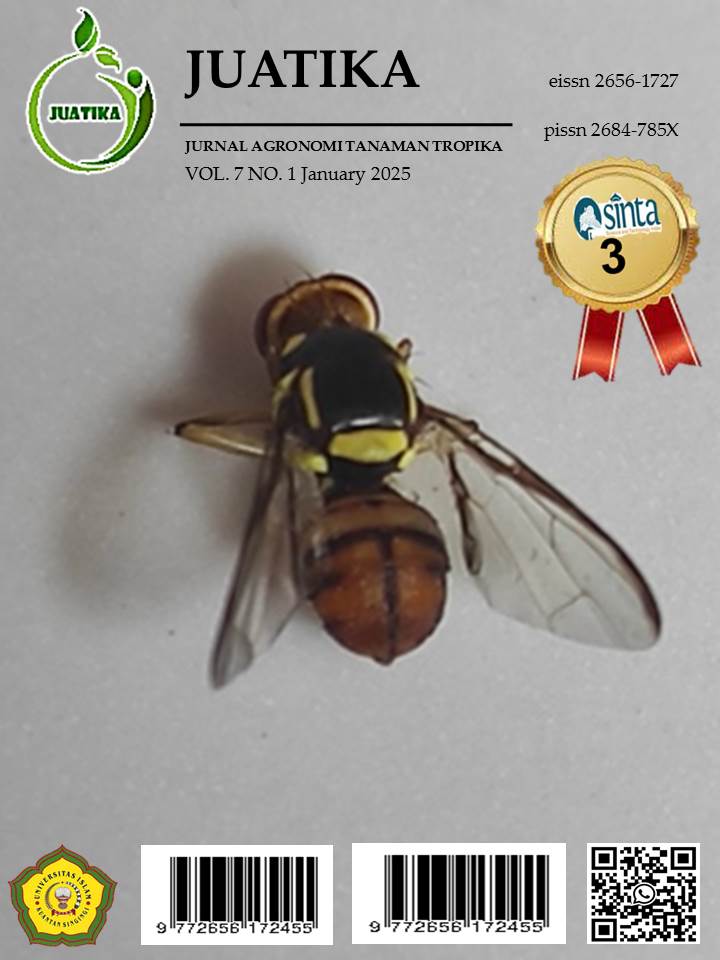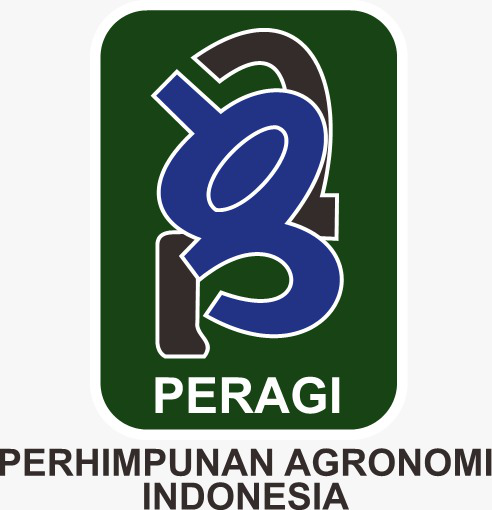Identification of The Causes of Base Rot Disease of Palm Oil in Two Villages in Kampar and Siak Districts of Riau Province
Abstract
Palm oil (Elaeis guineensis Jacq.) is an important plantation crop in Indonesia including in Riau Province. Palm oil productivity in Riau has decreased due to several factors, one of which is disease. An important disease in palm oil plantations is stem base rot (BPB) caused by the fungus Ganoderma sp. This study aims to identify the causes of BPB disease of palm oil in Deli Makmur Village, Kampar Regency and Jati Baru Village, Siak Regency. This research was conducted using survey and observation methods in palm oil plantations in two villages in Kampar and Siak Districts. The identification of pathogens was carried out based on morphological characteristics by making macroscopic and microscopic observations. Initial diagnosis based on symptoms and signs palm oil plants found in Deli Makmur Village and in Jati Baru Village showed symptoms of stem base rot (BPB). The results of morphological identification show that the pathogen causing BPB disease is Ganoderma sp. The macroscopic and microscopic characteristics of the two Ganoderma sp. fungal isolates are slightly different, where the fungal isolate from Deli Makmur Village mycelium grows sideways, has a smooth and very thick texture, there are concentric rings, crystals and cuticular cells. While the mushroom isolate from Jati Baru Village mycelium grows sideways, has a fine texture, is quite thick, and there are no ring-shaped concentric, crystals and cuticular cells.
Downloads
References
Aditya, P., Lestari, W., Sitanggang, K. D., & Septiyani, I. A. P. (2024). Isolasi dan Karakteristik Jamur Dari Ganoderma di Desa Pernantian Perkebunan PT. Umada. Jurnal Pengabdian Kepada Masyarakat, 14(1). https://doi.org/10.30999/jpkm.v14i1.3317
Alviodinasyari, R., Martina, A., & Lestari, W. (2015). Pengendalian Ganoderma boninense Oleh Trichoderma sp. SBJ8 Pada kecambah dan Bibit Kelapa Sawit (Elaeis guineensis Jacq.) di Tanah Gambut. JOM FMIPA, 2(1).
Andriani, D., Okalia, D., & Seprido, S. (2022). Exploration And Characterization Of Fungi From Oil Palm Rhizosphere (Elaeis guneensis jacq) On People's Plantations In Kuantan Singingi Regency. Jurnal Agronomi Tanaman Tropika (JUATIKA), 4(1), 198-205.
Badalyan, S. M., Gharibyan, N. G., Iotti, M., & Zambonelli, A. (2019). Morphological and ecological screening of different collections of medicinal white-rot bracket fungus Ganoderma adspersum (Schulzer) Donk (Agaricomycetes, Polyporales). Italian Journal of Mycology, 48, 1–15. https://doi.org/10.6092/issn.2531- 7342/9092
Castillo, S. Y., Rodríguez, M. C., González, L. F., Zúñiga, L. F., Mestizo, Y. A., Medina, H. C., Montoya, C., Morales, A., Romero,
H. M., & Sarria, G. A. (2022). Ganoderma zonatum Is the Causal Agent of Basal Stem Rot in Oil Palm in Colombia. Journal of
Fungi, 8(3). https://doi.org/10.3390/jof8030230
Dahang, D., Nainggolan, L. P., Sembiring, R., Sembiring, S., Tarigan, S., Rajagukguk, B. H., & Br Karo, S. (2021). Pengendalian Penyakit Ganoderma Pada Kelapa Sawit dengan Menggunakan Jamur Endofitik Hendersonia. JMM (Jurnal Masyarakat Mandiri), 5(2), 548–559. https://doi.org/10.31764/jmm.v5i2.4090
Direktorat Jenderal Perkebunan. (2022). Statistik Perkebunan Unggulan Nasional 2019-2021 (D. Gartina & R. L. L. Sukriya, Eds.). Sekretariat Direktorat Jenderal Perkebunan.
Furtado, J. S. (1966). Significance of The Clamp-Connection in the Basidiomycetes. Persoonia, 4(2), 125–144.
Hamzah, A., Saputra, R., Puspita, F., Nasrul, B., Irfandri, & Depari, N.
S. (2021). Ganoderma diversity from smallholder oil palm plantations in peatlands of kampar district, indonesia based on mycelia morphology and somatic incompatibility. Biodiversitas, 22(1), 16–22. https://doi.org/10.13057/biodiv/d220103
Hutagaol, P., Wirianata, H., & Kristalisasi, E. N. (2024). Perkembangan Penyakit Busuk Batang pada Kelapa Sawit Pasca Peremajaan Tanaman. Jurnal Agro Industri Perkebunan, 12(1), 41–50. https://doi.org/10.25181/jaip.v12i1.3272
Khoo, Y. W., & Chong, K. P. (2023). Ganoderma boninense: general characteristics of pathogenicity and methods of control. Frontiers in Plant Science, 14.
https://doi.org/10.3389/fpls.2023.1156869
Kusdiana, A. P. J., Sinaga, M. S., & Tondok, E. T. (2021). Diagnosis Penyebab Penyakit Baru Gugur Daun Karet (Hevea brasiliensis Muell. Arg.). Jurnal Penelitian Karet, 38(2), 165–178. https://doi.org/10.22302/ppk.jpk.v2i38.728
Loyd, A. L., Barnes, C. W., Held, B. W., Schink, M. J., Smith, M. E., Smith, J. A., & Blanchette, R. A. (2018). Elucidating “lucidum”: Distinguishing the diverse laccate Ganoderma species of the United States. PLoS ONE, 13(7). https://doi.org/10.1371/journal.pone.0199738
Luangharn, T., Karunarathna, S. C., Mortimer, P. E., Hyde, K. D., & Xu,
J. (2020). Morphology, phylogeny and culture characteristics of ganoderma gibbosum collected from kunming, yunnan province, china. Phyton-International Journal of Experimental Botany, 89(3), 743–764. https://doi.org/10.32604/phyton.2020.09690
Maharany, R., Wagino, Guntoro, & Syahputra, R. (2024). Pengaruh Penyakit Busuk Pangkal Batang (Ganoderma boninense) Terhadap Penurunan Populasi Kelapa Sawit (Elaeis guineensis Jacq.) di PT Bakrie Sumatera Plantations Tbk. Jurnal Agrium, 21(2), 82–89.
Money, N. P. (2016). Fungal Diversity. In The Fungi: Third Edition (pp. 1–36). Academic Press. https://doi.org/10.1016/B978-0-12- 382034-1.00001-3
Puspitasari, D., & Rimbawanto, A. (2010). Uji Somatik Inkompatibiltas Ganoderma philippii Untuk Mengetahui Pola Sebaran Penyakit Busuk Akar Pada Tanaman Acacia mangium. Jurnal Pemuliaan Tanaman Hutan, 4(1), 49–61.
Rakib, M. R. M., Bong, C.-F. J., Khairulmazmi, A., & Idris, A. S. (2014). Genetic and Morphological Diversity of Ganoderma species Isolated from Infected Oil Palms (Elaeis guineensis). International Journal of Agriculture & Biology, 16(4). http://www.fspublishers.org
Salsabila, A., Ramdan, E. P., Asnur, P., & Hidayat, H. (2022). Survei Penyakit Busuk Pangkal Batang Kelapa Sawit di Kebun Cikasungka, PT Perkebunan Nusantara VIII, Bogor. Agrosains : Jurnal Penelitian Agronomi, 24(1), 1–5. https://doi.org/10.20961/agsjpa.v24i1.56720
Semangun, H. (2008). Penyakit-Penyakit Tanaman Perkebunan di Indonesia. Gadjah Mada University Press.
Sunarko. (2007). Petunjuk Praktis Budidaya & Pengelolaan Kelapa Sawit. PT Agromedika Pustaka.
Susanto, A., Prasetyo, A. E., & Wening, S. (2013). Laju Infeksi Ganoderma pada Empat Kelas Tekstur Tanah. Jurnal Fitopatologi Indonesia, 9(2), 39–46. https://doi.org/10.14692/jfi.9.2.39
Yu, G., & Chong, K. P. (2018). Selected Biomarkers from Oil Palm- Ganoderma Infected Tissues for Detection of Basal Stem Rot Disease. WMSU Research Journal, 37, 1–13. www.wmsu.edu.ph/research_journal
Yosephine, I. O., Effendi, Z., Guntoro, G., & Ardi, I. Z. S. (2024). Analysis of The Effectiveness of Controlling Ganoderma boninense Attacks Palm Oil (Elaeis guineensis Jacq) In Producing Plants At Pt. Perkebunan Nusantara III Kebun Sei Putih. Jurnal Agronomi Tanaman Tropika (JUATIKA), 6(2), 650-656
Copyright (c) 2024 Yetti Elfina, Irfandri, Aisyah Sabirunah, Widya Ningsih

This work is licensed under a Creative Commons Attribution 4.0 International License.
Authors who publish with Jurnal Agronomi Tanaman Tropika (JUATIKA) agree to the following terms:
Authors retain copyright and grant the Jurnal Agronomi Tanaman Tropika (JUATIKA) right of first publication with the work simultaneously licensed under a Creative Commons Attribution License (CC BY 4.0) that allows others to share (copy and redistribute the material in any medium or format) and adapt (remix, transform, and build upon the material for any purpose, even commercially) with an acknowledgment of the work's authorship and initial publication in Jurnal Agronomi Tanaman Tropika (JUATIKA).
Authors are able to enter into separate, additional contractual arrangements for the non-exclusive distribution of the journal's published version of the work (e.g., post it to an institutional repository or publish it in a book), with an acknowledgment of its initial publication in Jurnal Agronomi Tanaman Tropika (JUATIKA). Authors are permitted and encouraged to post their work online (e.g., in institutional repositories or on their website) prior to and during the submission process, as it can lead to productive exchanges, as well as earlier and greater citation of published work.







 More Information
More Information



